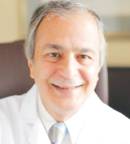In a single-center phase II trial reported in The Lancet Oncology, Nasser K. Altorki, MD, and colleagues found that neoadjuvant durvalumab plus stereotactic body radiotherapy (SBRT) resulted in a markedly higher major pathologic response rate vs durvalumab alone in patients with early-stage non–small cell lung cancer (NSCLC).
As stated by the authors, “Previous phase II trials of neoadjuvant anti–PD-1 or anti–PD-L1 monotherapy in patients with early-stage NSCLC have reported major pathological response rates in the range of 15% to 45%. Evidence suggests that stereotactic body radiotherapy might be a potent immunomodulator in advanced NSCLC.”

Nasser K. Altorki, MD
Study Details
In the open-label trial, 60 patients at NewYork-Presbyterian and Weill Cornell Medical Center were randomly assigned between January 2017 and September 2020 to receive durvalumab plus radiotherapy (n = 30) or durvalumab alone (n = 30). All patients received two cycles of durvalumab 3 weeks apart at a dose of 1.12 g via intravenous infusion over 60 minutes. Radiotherapy consisted of three consecutive daily fractions of 8 Gy delivered to the primary tumor immediately before the first cycle of durvalumab.
Patients without systemic disease progression underwent surgical resection. The primary endpoint was major pathologic response in the primary tumor in the intention-to-treat population.
Major Pathologic Response Rates
In each group, 26 (87%) of 30 patients had tumors surgically resected. Among the four patients in the durvalumab plus radiotherapy group not undergoing resection, one died prior to surgery and three had disease progression. Among the four patients in the durvalumab group not undergoing resection, one died prior to surgery, one declined surgery, and two had progressive disease.
A major pathologic response was observed in 16 (53.3%, 95% confidence interval [CI] = 34.3%–71.7%) of 30 patients in the durvalumab plus radiotherapy group vs 2 (6.7%, 95% CI = 0.8%–22.1%) of 30 in the durvalumab group (crude odds ratio = 16.0, 95% CI = 3.2–79.6, P < .0001).
Of the 16 patients in the durvalumab plus radiotherapy group with major pathological response, 8 (50%) had a complete pathologic response. No complete pathologic responses were observed in the durvalumab group. In the dual therapy group, responses were observed in 8 (44%) of 18 patients with adenocarcinoma and 8 (66%) of 12 with squamous cell carcinoma. Both responses in the durvalumab group occurred in patients with squamous cell carcinoma.
KEY POINTS
- Major pathologic response was observed in 53% of the durvalumab plus radiotherapy group vs 7% of the durvalumab monotherapy group.
- Complete pathologic response was observed in half of patients with major response in the durvalumab plus radiotherapy group.
Adverse Events
The second cycle of durvalumab was withheld in three patients (10%) in the durvalumab plus radiotherapy group due to immune-related adverse events (grade 3 hepatitis, grade 2 pancreatitis, and grade 3 fatigue and thrombocytopenia). Grade 3 and 4 adverse events occurred in six patients (20%) in the durvalumab plus radiotherapy group and five (17%) in the durvalumab group, with the most common being increased lipase (10%) in the durvalumab plus radiotherapy group and hyponatremia (10%) in the durvalumab group.
A total of 10 serious adverse events occurred in two patients (7%) in each group; 6 events were considered related to treatment, consisting of fatigue in two patients and adrenal insufficiency, pancreatitis, hyponatremia, and decreased platelet count in one patient each. There were no treatment-related deaths or deaths in the first 30 days after surgery.
The investigators concluded, “Neoadjuvant durvalumab combined with stereotactic body radiotherapy is well tolerated, safe, and associated with a high major pathological response rate. This neoadjuvant strategy should be validated in a larger trial.”
Dr. Altorki, of the Department of Cardiothoracic Surgery, Weill Cornell Medicine–NewYork-Presbyterian Hospital, is the corresponding author for The Lancet Oncology article.
Disclosure: The study was funded by AstraZeneca. For full disclosures of the study authors, visit thelancet.com.

